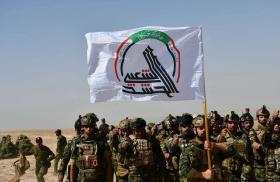
Iraq’s Drone and Rocket Epidemic, By the Numbers

Attacks on coalition points of presence are increasing in quantity and quality, making U.S. fatalities increasingly likely unless deterrence is restored.
The U.S. airstrike on Iraqi militia bases in the early hours of June 28 (local Iraqi time) came in response to a growing epidemic of drone and rocket (i.e., indirect fire) attacks on U.S. and Iraqi targets. This short report summarizes the key trends in such attacks over the past year.
Trend 1: The muqawama are escalating, deterrence is deteriorating.
Indirect fire trends in Iraq spiked at 13 a month in January 2020 after the U.S. killing of Qasem Soleimani and Abu Mahdi al-Muhandis, then dropped to as low as 2. They spiked again at 12 in August 2020, then dropped off to 1-2 per month as U.S. retaliatory threats intensified and the muqawama (resistance factions) declared a "conditional truce." Now they are heading up again, with a major qualitative jump as drones outnumber rockets for the first time. Deterrence has very clearly deteriorated since January 2021, which may coincide with the end of the Trump administration’s threat of disproportionate retaliation. In the past, such escalation of indirect fire has typically resulted in U.S. deaths and has only stopped when deterrence was firmly reimposed.
Trend 2: The muqawama are accepting a greater risk of killing U.S. persons.
It is instructive to look at the percentage of muqawama attacks that have targeted “points of presence,” meaning sites at which coalition personnel are actually present. Until summer 2020, all muqawama attacks were rocket strikes aimed at such points, an inherently risky tactic that could cause American casualties and draw U.S. retaliation. From July 2020, the "convoy strategy" saw the muqawama largely transfer their kinetic activities into a "safer" space, attacking Iraqi-manned logistical convoys that contain no coalition personnel—a strategy that Militia Spotlight has characterized as “fake resistance.”
This trend may now be changing again. A key question for analysts is whether the growing number of drone and rocket strikes on coalition points of presence (making up nearly a third of attacks in May-June 2021) is a return to more risky and genuine resistance tactics. Unguided rockets are still being fired, with the inherent risk of killing personnel; drones are more controllable but are still not assuredly nonlethal, being guided by GPS waypoints as opposed to realtime television imagery.
Trend 3: Militia drone attacks are growing rapidly in quantity and quality.
There have been more drone attacks and finds in Iraq than U.S. government metrics suggest. By Militia Spotlight’s count, 10 drone attacks have been launched in 2021 against targets inside Iraq (plus one drone strike originating in Iraq and striking Riyadh, Saudi Arabia).
- March 4: Drone penetration of leadership complexes in Baghdad and Erbil
- April 14: Strike on U.S. hangar in Erbil International Airport
- April 28: Strike on a coalition site
- May 8: Strike on al-Asad Air Base
- May 11: Strike on a coalition site near Erbil
- June 6: Two-drone strike on al-Asad Air Base
- June 9: Strike on Baghdad International Airport’s coalition site
- June 15: Two-drone strike on Baghdad International Airport’s coalition site
- June 20: Strike on al-Asad Air Base
- June 27: Four-drone strike close to leadership complexes in Erbil
The strikes have employed three main types of drone: the main variant is a so-called KAS-04 or Sammad fixed-wing drone first employed by Iranian-supplied Houthi forces in Yemen. The June 9 and June 15 drone attacks against the coalition annex in Baghdad International Airport used smaller drones that appear to be reverse-engineered U.S. Switchblade and Coyote loitering munitions, which militias have captured in Syria. The June 27 Erbil attacks involved a third family of drones to be exposed this year in Iraq, which marry warheads bearing Iranian manufacturing labels with a variety of body, wing, and motor components. All of the drones appear to be GPS-guided with a preprogrammed set of waypoints. The drones also show signs of being very precisely targeted on coalition intelligence, surveillance, and reconnaissance (ISR) assets and missile defenses, which is likely an effort to drive these assets out of Iraq.







